The Last of the Mohicans and Indigenous People Portrayal in Media
VerifiedAdded on 2023/01/05
|9
|2567
|56
Essay
AI Summary
This essay explores the portrayal of indigenous people in Canadian media, focusing on the film 'The Last of the Mohicans' as a case study. The paper begins with a proposal outlining the importance of understanding how indigenous people are represented in various media forms, including news, film, and art. The research question examines whether the media accurately portrays indigenous people or perpetuates stereotypical representations. The introduction argues that media, particularly film, significantly reflects society and influences perceptions. The essay provides details about the film 'The Last of the Mohicans,' which depicts the conflicts between colonists and indigenous tribes, highlighting the cultural biases. The analysis delves into the film's portrayal of indigenous people, discussing the romanticized vision of their lifestyle and the stereotypes presented. The essay also references other films like 'Indian Horse' to show the depiction of indigenous people. The conclusion emphasizes the importance of understanding the portrayal of indigenous people and the impact of media on societal perceptions, while also pointing out the conflicts and influences of colonial groups on the tribes. The paper uses the film to explore the different stereotypes that exist in the media.
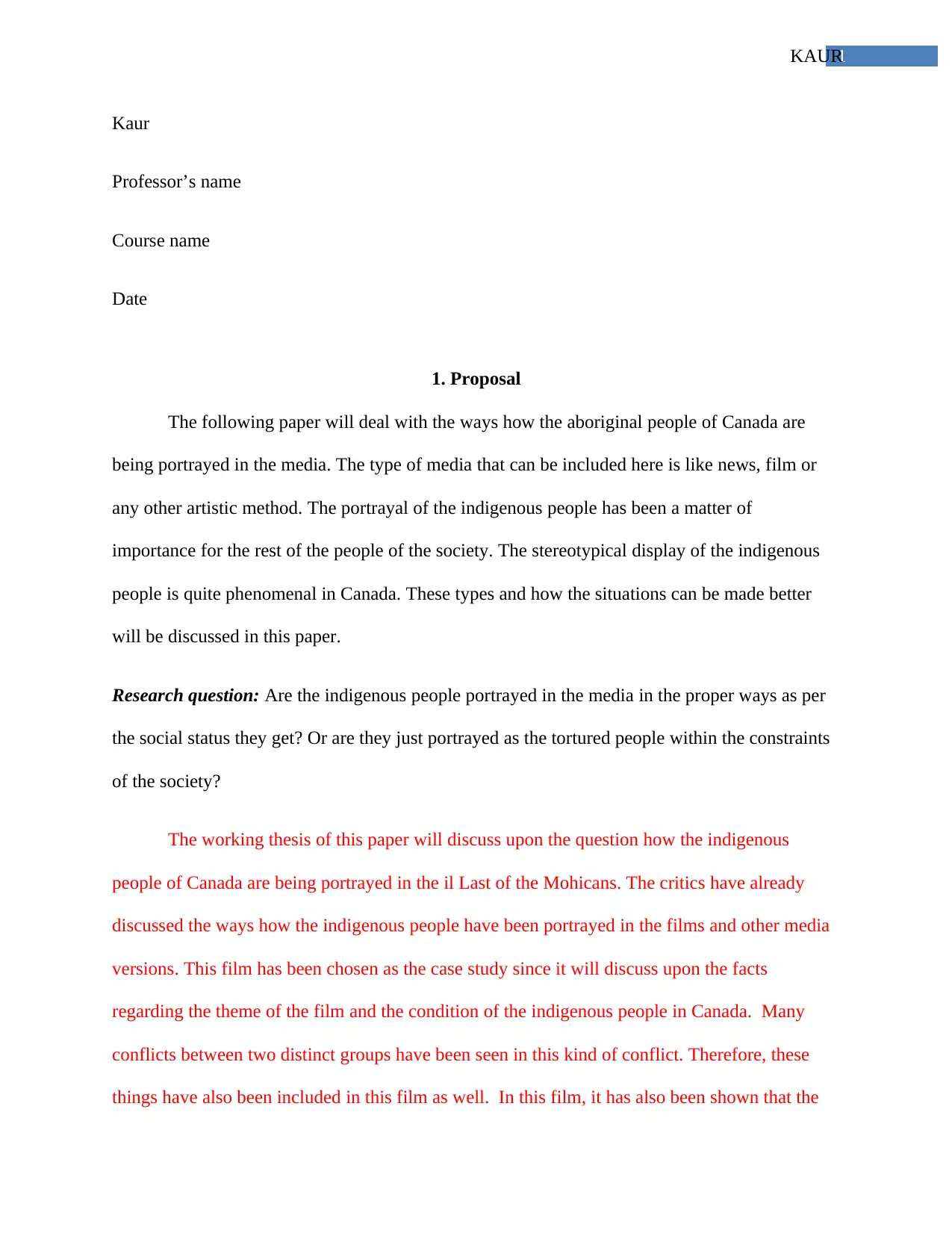
1KAUR
Kaur
Professor’s name
Course name
Date
1. Proposal
The following paper will deal with the ways how the aboriginal people of Canada are
being portrayed in the media. The type of media that can be included here is like news, film or
any other artistic method. The portrayal of the indigenous people has been a matter of
importance for the rest of the people of the society. The stereotypical display of the indigenous
people is quite phenomenal in Canada. These types and how the situations can be made better
will be discussed in this paper.
Research question: Are the indigenous people portrayed in the media in the proper ways as per
the social status they get? Or are they just portrayed as the tortured people within the constraints
of the society?
The working thesis of this paper will discuss upon the question how the indigenous
people of Canada are being portrayed in the il Last of the Mohicans. The critics have already
discussed the ways how the indigenous people have been portrayed in the films and other media
versions. This film has been chosen as the case study since it will discuss upon the facts
regarding the theme of the film and the condition of the indigenous people in Canada. Many
conflicts between two distinct groups have been seen in this kind of conflict. Therefore, these
things have also been included in this film as well. In this film, it has also been shown that the
Kaur
Professor’s name
Course name
Date
1. Proposal
The following paper will deal with the ways how the aboriginal people of Canada are
being portrayed in the media. The type of media that can be included here is like news, film or
any other artistic method. The portrayal of the indigenous people has been a matter of
importance for the rest of the people of the society. The stereotypical display of the indigenous
people is quite phenomenal in Canada. These types and how the situations can be made better
will be discussed in this paper.
Research question: Are the indigenous people portrayed in the media in the proper ways as per
the social status they get? Or are they just portrayed as the tortured people within the constraints
of the society?
The working thesis of this paper will discuss upon the question how the indigenous
people of Canada are being portrayed in the il Last of the Mohicans. The critics have already
discussed the ways how the indigenous people have been portrayed in the films and other media
versions. This film has been chosen as the case study since it will discuss upon the facts
regarding the theme of the film and the condition of the indigenous people in Canada. Many
conflicts between two distinct groups have been seen in this kind of conflict. Therefore, these
things have also been included in this film as well. In this film, it has also been shown that the
Secure Best Marks with AI Grader
Need help grading? Try our AI Grader for instant feedback on your assignments.
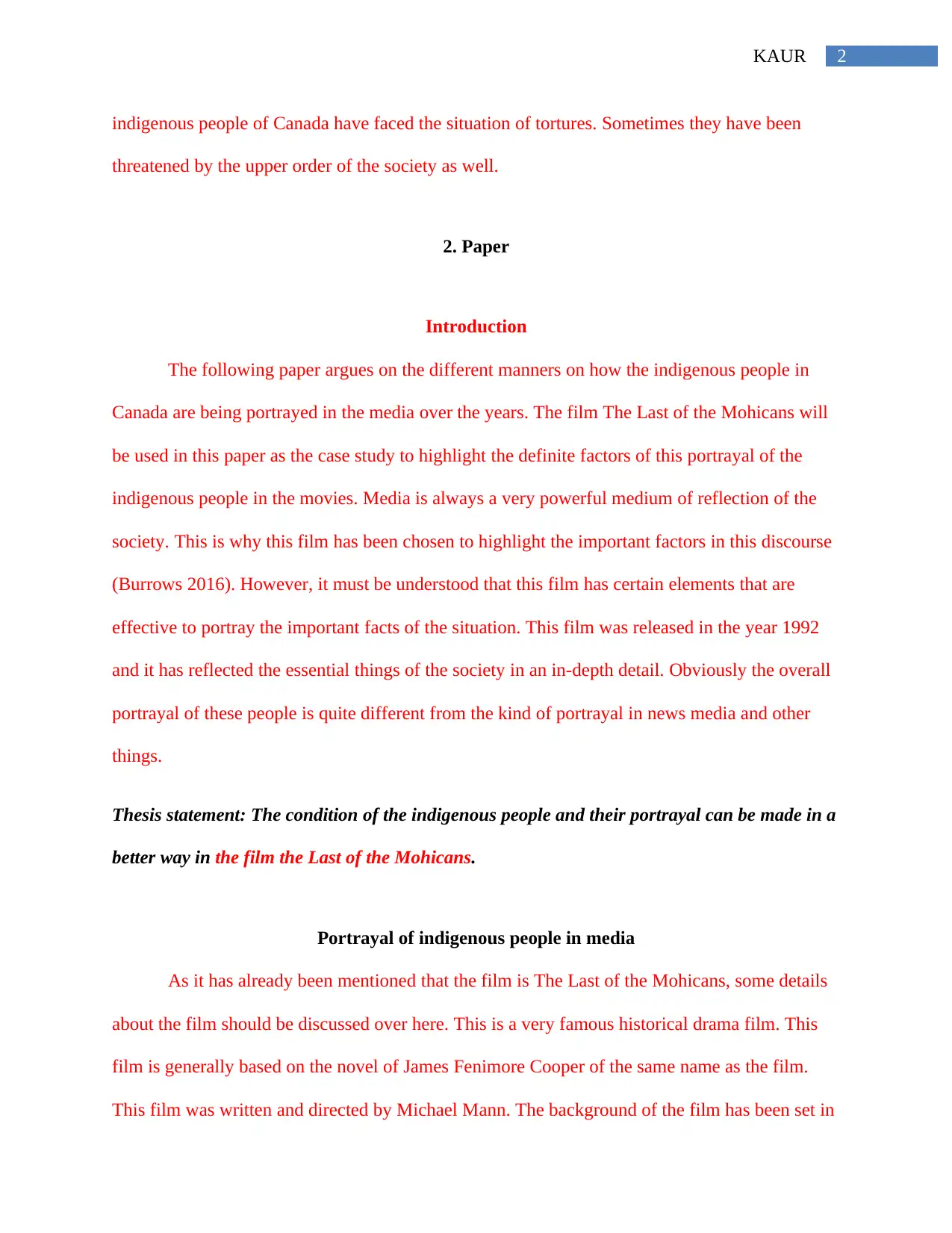
2KAUR
indigenous people of Canada have faced the situation of tortures. Sometimes they have been
threatened by the upper order of the society as well.
2. Paper
Introduction
The following paper argues on the different manners on how the indigenous people in
Canada are being portrayed in the media over the years. The film The Last of the Mohicans will
be used in this paper as the case study to highlight the definite factors of this portrayal of the
indigenous people in the movies. Media is always a very powerful medium of reflection of the
society. This is why this film has been chosen to highlight the important factors in this discourse
(Burrows 2016). However, it must be understood that this film has certain elements that are
effective to portray the important facts of the situation. This film was released in the year 1992
and it has reflected the essential things of the society in an in-depth detail. Obviously the overall
portrayal of these people is quite different from the kind of portrayal in news media and other
things.
Thesis statement: The condition of the indigenous people and their portrayal can be made in a
better way in the film the Last of the Mohicans.
Portrayal of indigenous people in media
As it has already been mentioned that the film is The Last of the Mohicans, some details
about the film should be discussed over here. This is a very famous historical drama film. This
film is generally based on the novel of James Fenimore Cooper of the same name as the film.
This film was written and directed by Michael Mann. The background of the film has been set in
indigenous people of Canada have faced the situation of tortures. Sometimes they have been
threatened by the upper order of the society as well.
2. Paper
Introduction
The following paper argues on the different manners on how the indigenous people in
Canada are being portrayed in the media over the years. The film The Last of the Mohicans will
be used in this paper as the case study to highlight the definite factors of this portrayal of the
indigenous people in the movies. Media is always a very powerful medium of reflection of the
society. This is why this film has been chosen to highlight the important factors in this discourse
(Burrows 2016). However, it must be understood that this film has certain elements that are
effective to portray the important facts of the situation. This film was released in the year 1992
and it has reflected the essential things of the society in an in-depth detail. Obviously the overall
portrayal of these people is quite different from the kind of portrayal in news media and other
things.
Thesis statement: The condition of the indigenous people and their portrayal can be made in a
better way in the film the Last of the Mohicans.
Portrayal of indigenous people in media
As it has already been mentioned that the film is The Last of the Mohicans, some details
about the film should be discussed over here. This is a very famous historical drama film. This
film is generally based on the novel of James Fenimore Cooper of the same name as the film.
This film was written and directed by Michael Mann. The background of the film has been set in
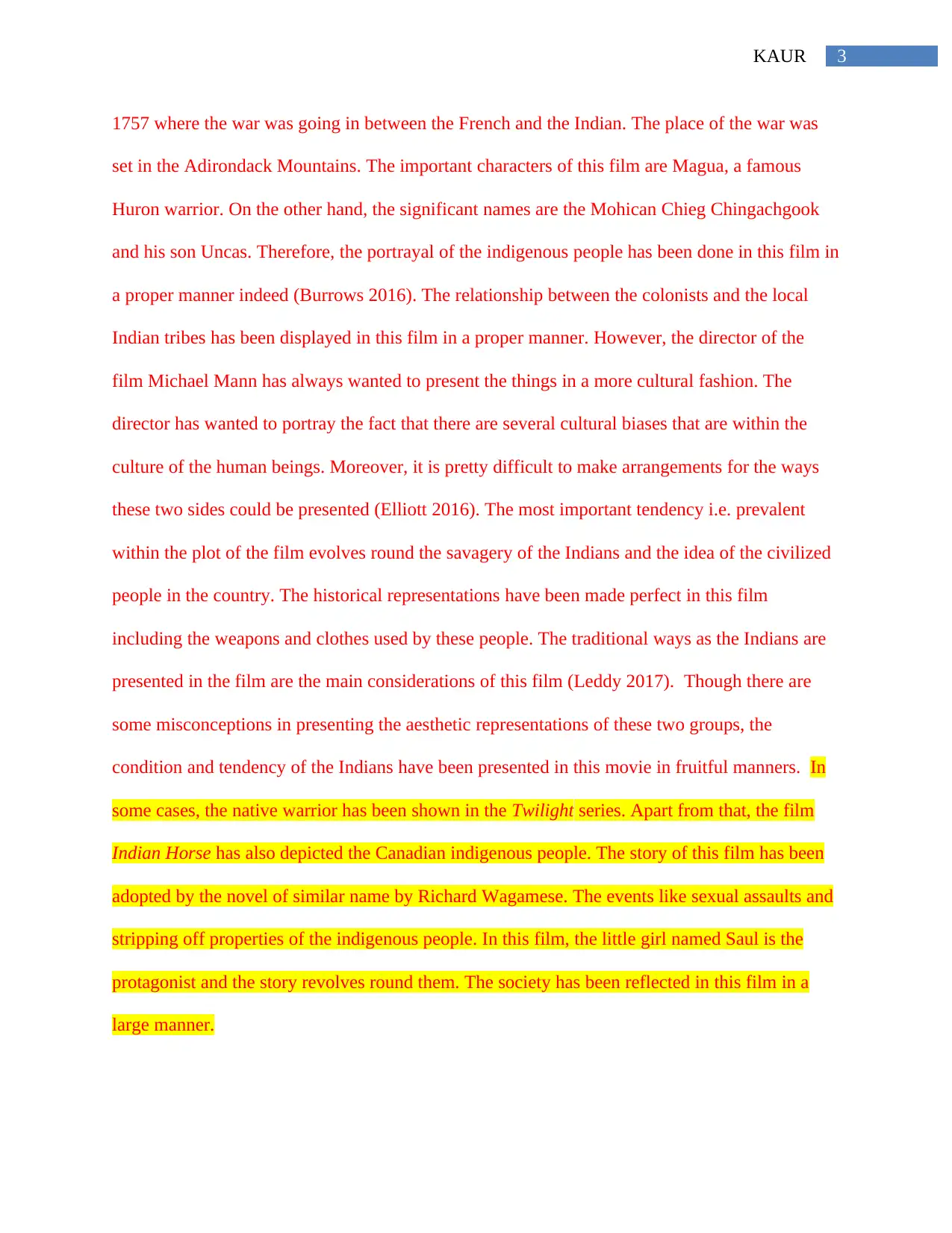
3KAUR
1757 where the war was going in between the French and the Indian. The place of the war was
set in the Adirondack Mountains. The important characters of this film are Magua, a famous
Huron warrior. On the other hand, the significant names are the Mohican Chieg Chingachgook
and his son Uncas. Therefore, the portrayal of the indigenous people has been done in this film in
a proper manner indeed (Burrows 2016). The relationship between the colonists and the local
Indian tribes has been displayed in this film in a proper manner. However, the director of the
film Michael Mann has always wanted to present the things in a more cultural fashion. The
director has wanted to portray the fact that there are several cultural biases that are within the
culture of the human beings. Moreover, it is pretty difficult to make arrangements for the ways
these two sides could be presented (Elliott 2016). The most important tendency i.e. prevalent
within the plot of the film evolves round the savagery of the Indians and the idea of the civilized
people in the country. The historical representations have been made perfect in this film
including the weapons and clothes used by these people. The traditional ways as the Indians are
presented in the film are the main considerations of this film (Leddy 2017). Though there are
some misconceptions in presenting the aesthetic representations of these two groups, the
condition and tendency of the Indians have been presented in this movie in fruitful manners. In
some cases, the native warrior has been shown in the Twilight series. Apart from that, the film
Indian Horse has also depicted the Canadian indigenous people. The story of this film has been
adopted by the novel of similar name by Richard Wagamese. The events like sexual assaults and
stripping off properties of the indigenous people. In this film, the little girl named Saul is the
protagonist and the story revolves round them. The society has been reflected in this film in a
large manner.
1757 where the war was going in between the French and the Indian. The place of the war was
set in the Adirondack Mountains. The important characters of this film are Magua, a famous
Huron warrior. On the other hand, the significant names are the Mohican Chieg Chingachgook
and his son Uncas. Therefore, the portrayal of the indigenous people has been done in this film in
a proper manner indeed (Burrows 2016). The relationship between the colonists and the local
Indian tribes has been displayed in this film in a proper manner. However, the director of the
film Michael Mann has always wanted to present the things in a more cultural fashion. The
director has wanted to portray the fact that there are several cultural biases that are within the
culture of the human beings. Moreover, it is pretty difficult to make arrangements for the ways
these two sides could be presented (Elliott 2016). The most important tendency i.e. prevalent
within the plot of the film evolves round the savagery of the Indians and the idea of the civilized
people in the country. The historical representations have been made perfect in this film
including the weapons and clothes used by these people. The traditional ways as the Indians are
presented in the film are the main considerations of this film (Leddy 2017). Though there are
some misconceptions in presenting the aesthetic representations of these two groups, the
condition and tendency of the Indians have been presented in this movie in fruitful manners. In
some cases, the native warrior has been shown in the Twilight series. Apart from that, the film
Indian Horse has also depicted the Canadian indigenous people. The story of this film has been
adopted by the novel of similar name by Richard Wagamese. The events like sexual assaults and
stripping off properties of the indigenous people. In this film, the little girl named Saul is the
protagonist and the story revolves round them. The society has been reflected in this film in a
large manner.
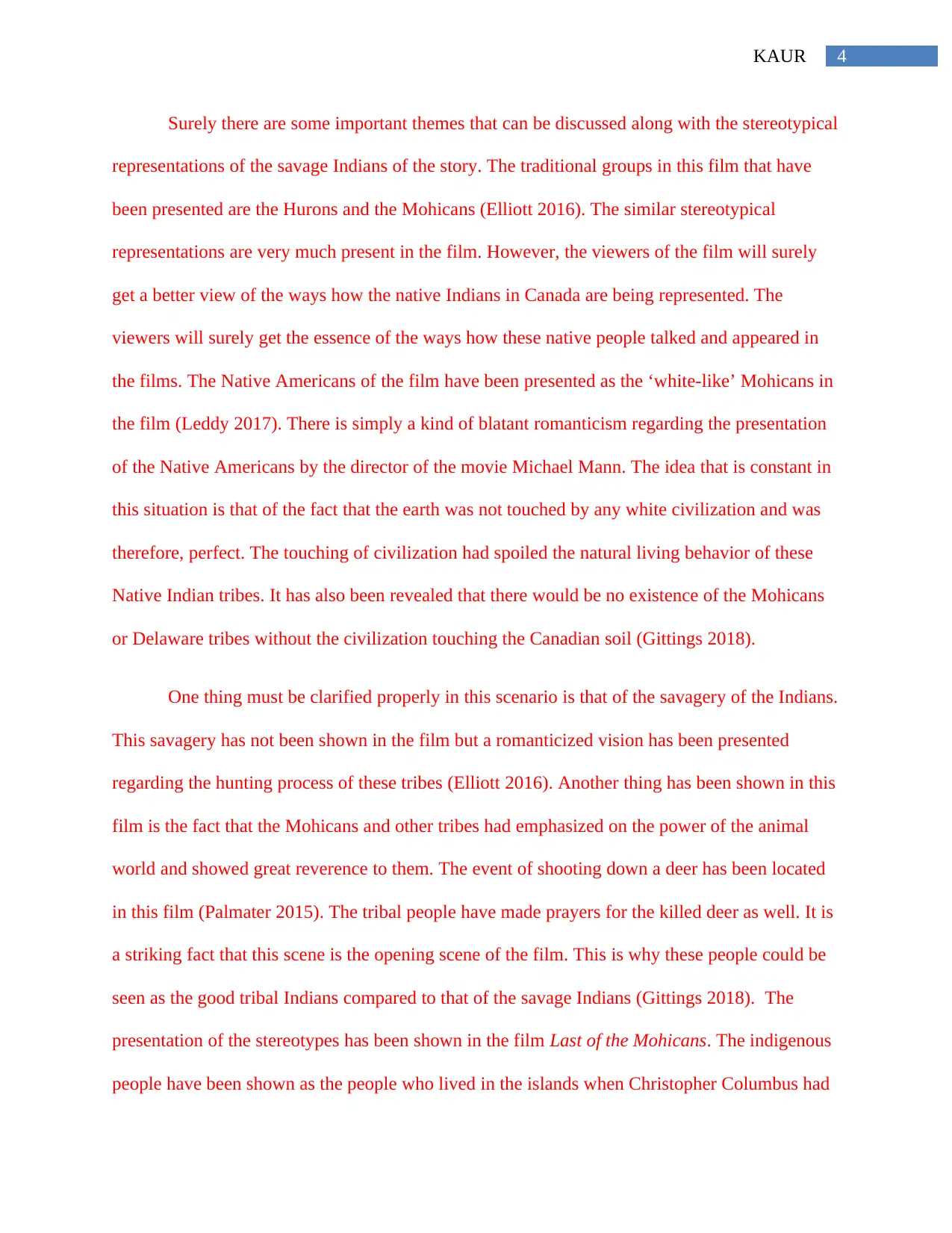
4KAUR
Surely there are some important themes that can be discussed along with the stereotypical
representations of the savage Indians of the story. The traditional groups in this film that have
been presented are the Hurons and the Mohicans (Elliott 2016). The similar stereotypical
representations are very much present in the film. However, the viewers of the film will surely
get a better view of the ways how the native Indians in Canada are being represented. The
viewers will surely get the essence of the ways how these native people talked and appeared in
the films. The Native Americans of the film have been presented as the ‘white-like’ Mohicans in
the film (Leddy 2017). There is simply a kind of blatant romanticism regarding the presentation
of the Native Americans by the director of the movie Michael Mann. The idea that is constant in
this situation is that of the fact that the earth was not touched by any white civilization and was
therefore, perfect. The touching of civilization had spoiled the natural living behavior of these
Native Indian tribes. It has also been revealed that there would be no existence of the Mohicans
or Delaware tribes without the civilization touching the Canadian soil (Gittings 2018).
One thing must be clarified properly in this scenario is that of the savagery of the Indians.
This savagery has not been shown in the film but a romanticized vision has been presented
regarding the hunting process of these tribes (Elliott 2016). Another thing has been shown in this
film is the fact that the Mohicans and other tribes had emphasized on the power of the animal
world and showed great reverence to them. The event of shooting down a deer has been located
in this film (Palmater 2015). The tribal people have made prayers for the killed deer as well. It is
a striking fact that this scene is the opening scene of the film. This is why these people could be
seen as the good tribal Indians compared to that of the savage Indians (Gittings 2018). The
presentation of the stereotypes has been shown in the film Last of the Mohicans. The indigenous
people have been shown as the people who lived in the islands when Christopher Columbus had
Surely there are some important themes that can be discussed along with the stereotypical
representations of the savage Indians of the story. The traditional groups in this film that have
been presented are the Hurons and the Mohicans (Elliott 2016). The similar stereotypical
representations are very much present in the film. However, the viewers of the film will surely
get a better view of the ways how the native Indians in Canada are being represented. The
viewers will surely get the essence of the ways how these native people talked and appeared in
the films. The Native Americans of the film have been presented as the ‘white-like’ Mohicans in
the film (Leddy 2017). There is simply a kind of blatant romanticism regarding the presentation
of the Native Americans by the director of the movie Michael Mann. The idea that is constant in
this situation is that of the fact that the earth was not touched by any white civilization and was
therefore, perfect. The touching of civilization had spoiled the natural living behavior of these
Native Indian tribes. It has also been revealed that there would be no existence of the Mohicans
or Delaware tribes without the civilization touching the Canadian soil (Gittings 2018).
One thing must be clarified properly in this scenario is that of the savagery of the Indians.
This savagery has not been shown in the film but a romanticized vision has been presented
regarding the hunting process of these tribes (Elliott 2016). Another thing has been shown in this
film is the fact that the Mohicans and other tribes had emphasized on the power of the animal
world and showed great reverence to them. The event of shooting down a deer has been located
in this film (Palmater 2015). The tribal people have made prayers for the killed deer as well. It is
a striking fact that this scene is the opening scene of the film. This is why these people could be
seen as the good tribal Indians compared to that of the savage Indians (Gittings 2018). The
presentation of the stereotypes has been shown in the film Last of the Mohicans. The indigenous
people have been shown as the people who lived in the islands when Christopher Columbus had
Secure Best Marks with AI Grader
Need help grading? Try our AI Grader for instant feedback on your assignments.
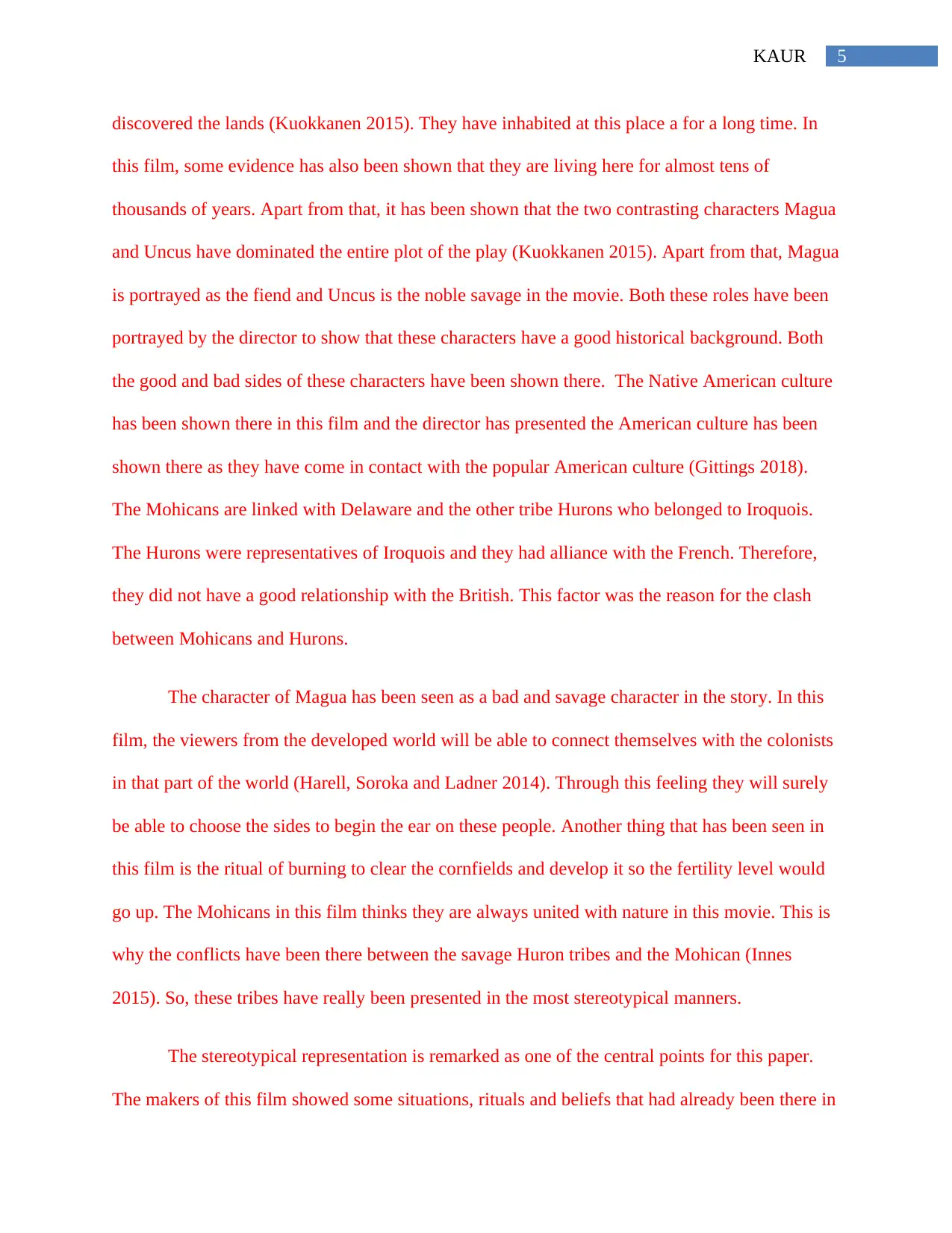
5KAUR
discovered the lands (Kuokkanen 2015). They have inhabited at this place a for a long time. In
this film, some evidence has also been shown that they are living here for almost tens of
thousands of years. Apart from that, it has been shown that the two contrasting characters Magua
and Uncus have dominated the entire plot of the play (Kuokkanen 2015). Apart from that, Magua
is portrayed as the fiend and Uncus is the noble savage in the movie. Both these roles have been
portrayed by the director to show that these characters have a good historical background. Both
the good and bad sides of these characters have been shown there. The Native American culture
has been shown there in this film and the director has presented the American culture has been
shown there as they have come in contact with the popular American culture (Gittings 2018).
The Mohicans are linked with Delaware and the other tribe Hurons who belonged to Iroquois.
The Hurons were representatives of Iroquois and they had alliance with the French. Therefore,
they did not have a good relationship with the British. This factor was the reason for the clash
between Mohicans and Hurons.
The character of Magua has been seen as a bad and savage character in the story. In this
film, the viewers from the developed world will be able to connect themselves with the colonists
in that part of the world (Harell, Soroka and Ladner 2014). Through this feeling they will surely
be able to choose the sides to begin the ear on these people. Another thing that has been seen in
this film is the ritual of burning to clear the cornfields and develop it so the fertility level would
go up. The Mohicans in this film thinks they are always united with nature in this movie. This is
why the conflicts have been there between the savage Huron tribes and the Mohican (Innes
2015). So, these tribes have really been presented in the most stereotypical manners.
The stereotypical representation is remarked as one of the central points for this paper.
The makers of this film showed some situations, rituals and beliefs that had already been there in
discovered the lands (Kuokkanen 2015). They have inhabited at this place a for a long time. In
this film, some evidence has also been shown that they are living here for almost tens of
thousands of years. Apart from that, it has been shown that the two contrasting characters Magua
and Uncus have dominated the entire plot of the play (Kuokkanen 2015). Apart from that, Magua
is portrayed as the fiend and Uncus is the noble savage in the movie. Both these roles have been
portrayed by the director to show that these characters have a good historical background. Both
the good and bad sides of these characters have been shown there. The Native American culture
has been shown there in this film and the director has presented the American culture has been
shown there as they have come in contact with the popular American culture (Gittings 2018).
The Mohicans are linked with Delaware and the other tribe Hurons who belonged to Iroquois.
The Hurons were representatives of Iroquois and they had alliance with the French. Therefore,
they did not have a good relationship with the British. This factor was the reason for the clash
between Mohicans and Hurons.
The character of Magua has been seen as a bad and savage character in the story. In this
film, the viewers from the developed world will be able to connect themselves with the colonists
in that part of the world (Harell, Soroka and Ladner 2014). Through this feeling they will surely
be able to choose the sides to begin the ear on these people. Another thing that has been seen in
this film is the ritual of burning to clear the cornfields and develop it so the fertility level would
go up. The Mohicans in this film thinks they are always united with nature in this movie. This is
why the conflicts have been there between the savage Huron tribes and the Mohican (Innes
2015). So, these tribes have really been presented in the most stereotypical manners.
The stereotypical representation is remarked as one of the central points for this paper.
The makers of this film showed some situations, rituals and beliefs that had already been there in
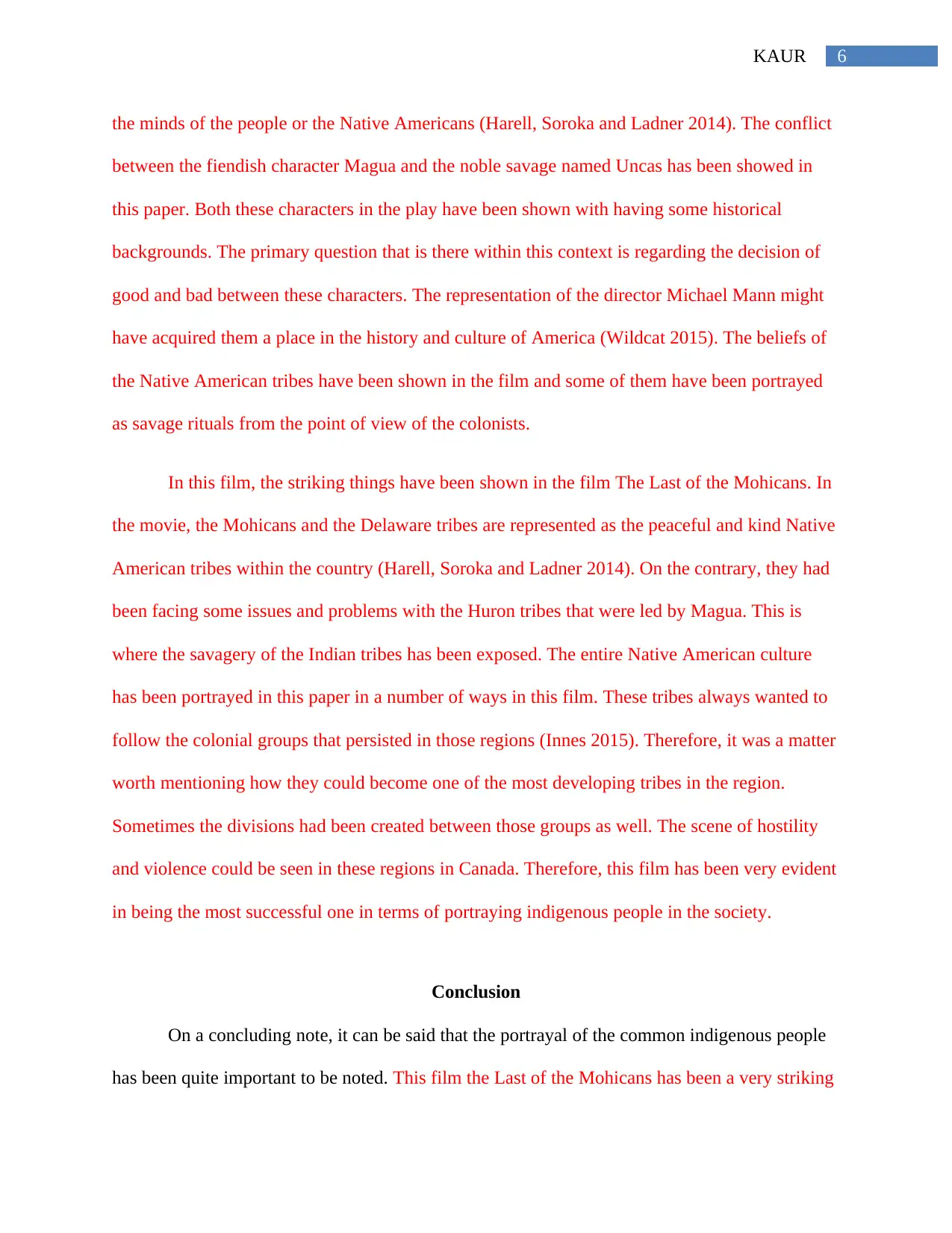
6KAUR
the minds of the people or the Native Americans (Harell, Soroka and Ladner 2014). The conflict
between the fiendish character Magua and the noble savage named Uncas has been showed in
this paper. Both these characters in the play have been shown with having some historical
backgrounds. The primary question that is there within this context is regarding the decision of
good and bad between these characters. The representation of the director Michael Mann might
have acquired them a place in the history and culture of America (Wildcat 2015). The beliefs of
the Native American tribes have been shown in the film and some of them have been portrayed
as savage rituals from the point of view of the colonists.
In this film, the striking things have been shown in the film The Last of the Mohicans. In
the movie, the Mohicans and the Delaware tribes are represented as the peaceful and kind Native
American tribes within the country (Harell, Soroka and Ladner 2014). On the contrary, they had
been facing some issues and problems with the Huron tribes that were led by Magua. This is
where the savagery of the Indian tribes has been exposed. The entire Native American culture
has been portrayed in this paper in a number of ways in this film. These tribes always wanted to
follow the colonial groups that persisted in those regions (Innes 2015). Therefore, it was a matter
worth mentioning how they could become one of the most developing tribes in the region.
Sometimes the divisions had been created between those groups as well. The scene of hostility
and violence could be seen in these regions in Canada. Therefore, this film has been very evident
in being the most successful one in terms of portraying indigenous people in the society.
Conclusion
On a concluding note, it can be said that the portrayal of the common indigenous people
has been quite important to be noted. This film the Last of the Mohicans has been a very striking
the minds of the people or the Native Americans (Harell, Soroka and Ladner 2014). The conflict
between the fiendish character Magua and the noble savage named Uncas has been showed in
this paper. Both these characters in the play have been shown with having some historical
backgrounds. The primary question that is there within this context is regarding the decision of
good and bad between these characters. The representation of the director Michael Mann might
have acquired them a place in the history and culture of America (Wildcat 2015). The beliefs of
the Native American tribes have been shown in the film and some of them have been portrayed
as savage rituals from the point of view of the colonists.
In this film, the striking things have been shown in the film The Last of the Mohicans. In
the movie, the Mohicans and the Delaware tribes are represented as the peaceful and kind Native
American tribes within the country (Harell, Soroka and Ladner 2014). On the contrary, they had
been facing some issues and problems with the Huron tribes that were led by Magua. This is
where the savagery of the Indian tribes has been exposed. The entire Native American culture
has been portrayed in this paper in a number of ways in this film. These tribes always wanted to
follow the colonial groups that persisted in those regions (Innes 2015). Therefore, it was a matter
worth mentioning how they could become one of the most developing tribes in the region.
Sometimes the divisions had been created between those groups as well. The scene of hostility
and violence could be seen in these regions in Canada. Therefore, this film has been very evident
in being the most successful one in terms of portraying indigenous people in the society.
Conclusion
On a concluding note, it can be said that the portrayal of the common indigenous people
has been quite important to be noted. This film the Last of the Mohicans has been a very striking
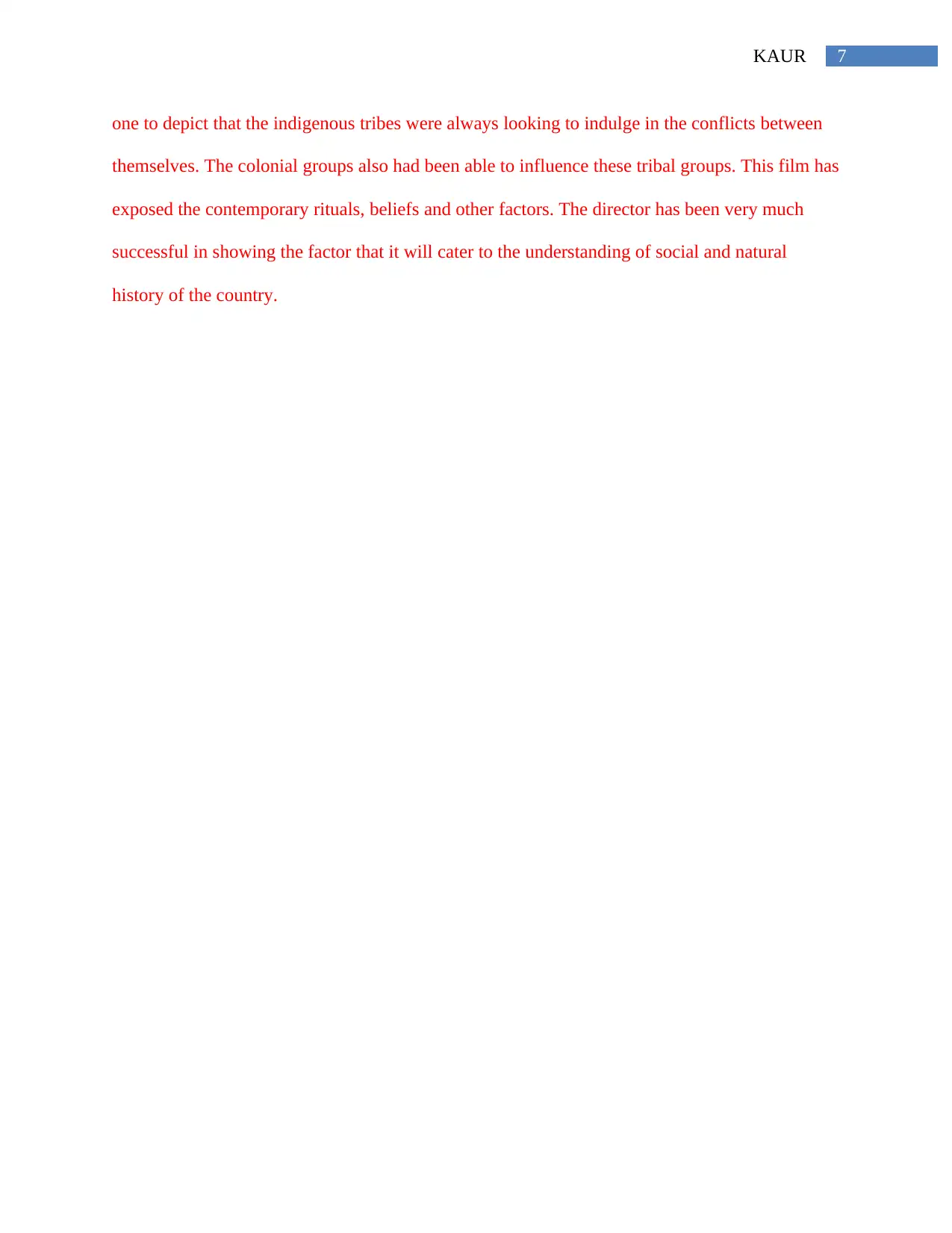
7KAUR
one to depict that the indigenous tribes were always looking to indulge in the conflicts between
themselves. The colonial groups also had been able to influence these tribal groups. This film has
exposed the contemporary rituals, beliefs and other factors. The director has been very much
successful in showing the factor that it will cater to the understanding of social and natural
history of the country.
one to depict that the indigenous tribes were always looking to indulge in the conflicts between
themselves. The colonial groups also had been able to influence these tribal groups. This film has
exposed the contemporary rituals, beliefs and other factors. The director has been very much
successful in showing the factor that it will cater to the understanding of social and natural
history of the country.
Paraphrase This Document
Need a fresh take? Get an instant paraphrase of this document with our AI Paraphraser
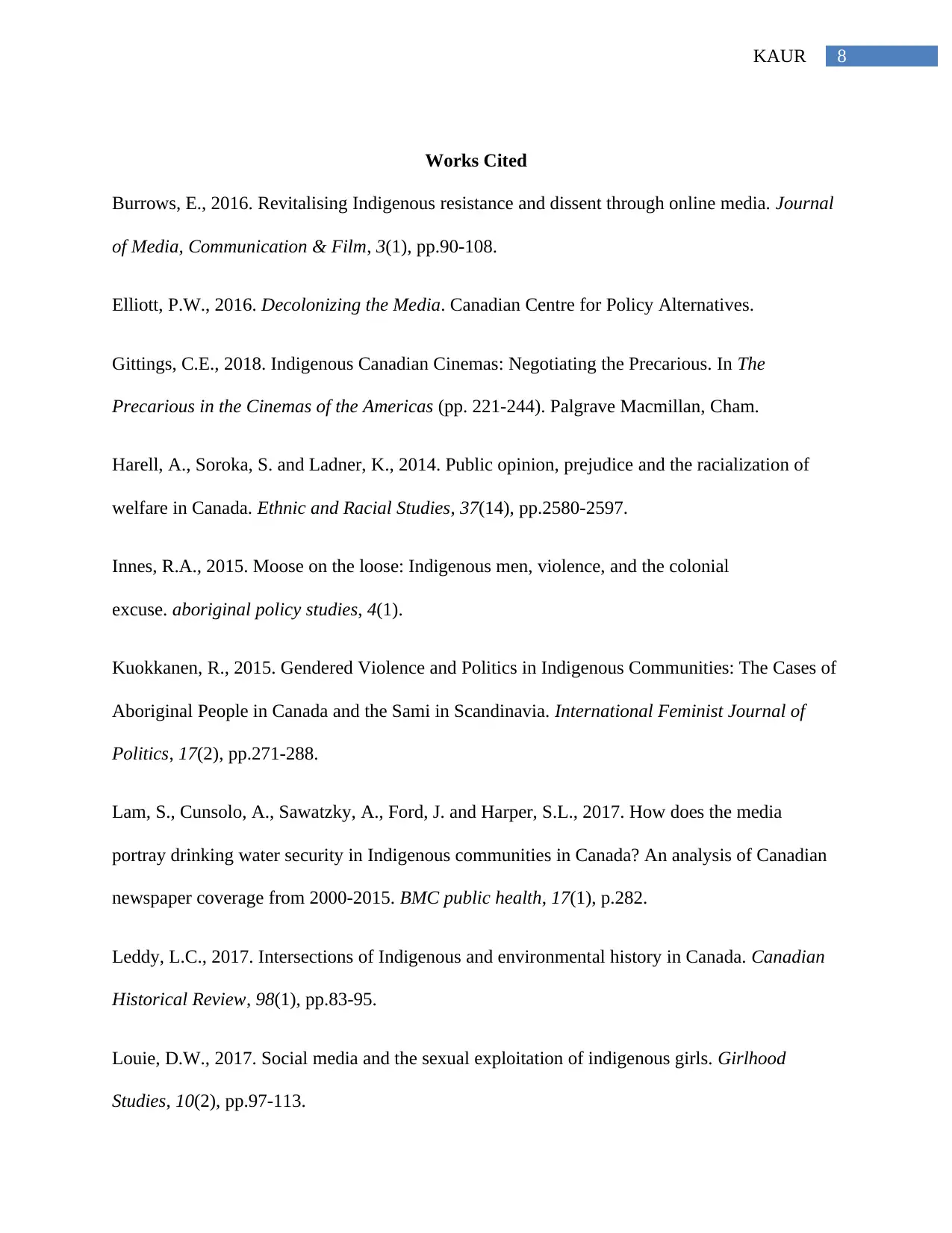
8KAUR
Works Cited
Burrows, E., 2016. Revitalising Indigenous resistance and dissent through online media. Journal
of Media, Communication & Film, 3(1), pp.90-108.
Elliott, P.W., 2016. Decolonizing the Media. Canadian Centre for Policy Alternatives.
Gittings, C.E., 2018. Indigenous Canadian Cinemas: Negotiating the Precarious. In The
Precarious in the Cinemas of the Americas (pp. 221-244). Palgrave Macmillan, Cham.
Harell, A., Soroka, S. and Ladner, K., 2014. Public opinion, prejudice and the racialization of
welfare in Canada. Ethnic and Racial Studies, 37(14), pp.2580-2597.
Innes, R.A., 2015. Moose on the loose: Indigenous men, violence, and the colonial
excuse. aboriginal policy studies, 4(1).
Kuokkanen, R., 2015. Gendered Violence and Politics in Indigenous Communities: The Cases of
Aboriginal People in Canada and the Sami in Scandinavia. International Feminist Journal of
Politics, 17(2), pp.271-288.
Lam, S., Cunsolo, A., Sawatzky, A., Ford, J. and Harper, S.L., 2017. How does the media
portray drinking water security in Indigenous communities in Canada? An analysis of Canadian
newspaper coverage from 2000-2015. BMC public health, 17(1), p.282.
Leddy, L.C., 2017. Intersections of Indigenous and environmental history in Canada. Canadian
Historical Review, 98(1), pp.83-95.
Louie, D.W., 2017. Social media and the sexual exploitation of indigenous girls. Girlhood
Studies, 10(2), pp.97-113.
Works Cited
Burrows, E., 2016. Revitalising Indigenous resistance and dissent through online media. Journal
of Media, Communication & Film, 3(1), pp.90-108.
Elliott, P.W., 2016. Decolonizing the Media. Canadian Centre for Policy Alternatives.
Gittings, C.E., 2018. Indigenous Canadian Cinemas: Negotiating the Precarious. In The
Precarious in the Cinemas of the Americas (pp. 221-244). Palgrave Macmillan, Cham.
Harell, A., Soroka, S. and Ladner, K., 2014. Public opinion, prejudice and the racialization of
welfare in Canada. Ethnic and Racial Studies, 37(14), pp.2580-2597.
Innes, R.A., 2015. Moose on the loose: Indigenous men, violence, and the colonial
excuse. aboriginal policy studies, 4(1).
Kuokkanen, R., 2015. Gendered Violence and Politics in Indigenous Communities: The Cases of
Aboriginal People in Canada and the Sami in Scandinavia. International Feminist Journal of
Politics, 17(2), pp.271-288.
Lam, S., Cunsolo, A., Sawatzky, A., Ford, J. and Harper, S.L., 2017. How does the media
portray drinking water security in Indigenous communities in Canada? An analysis of Canadian
newspaper coverage from 2000-2015. BMC public health, 17(1), p.282.
Leddy, L.C., 2017. Intersections of Indigenous and environmental history in Canada. Canadian
Historical Review, 98(1), pp.83-95.
Louie, D.W., 2017. Social media and the sexual exploitation of indigenous girls. Girlhood
Studies, 10(2), pp.97-113.
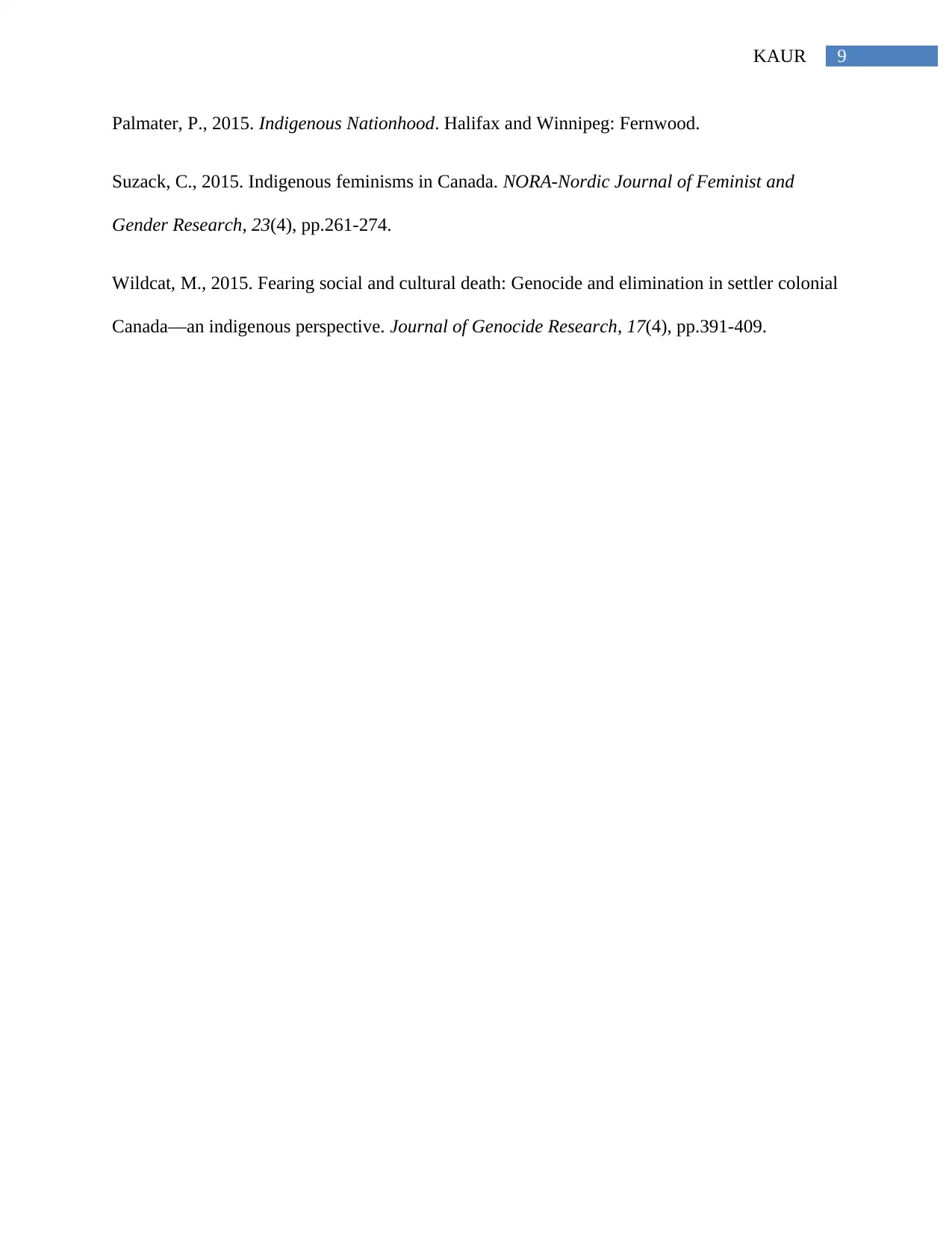
9KAUR
Palmater, P., 2015. Indigenous Nationhood. Halifax and Winnipeg: Fernwood.
Suzack, C., 2015. Indigenous feminisms in Canada. NORA-Nordic Journal of Feminist and
Gender Research, 23(4), pp.261-274.
Wildcat, M., 2015. Fearing social and cultural death: Genocide and elimination in settler colonial
Canada—an indigenous perspective. Journal of Genocide Research, 17(4), pp.391-409.
Palmater, P., 2015. Indigenous Nationhood. Halifax and Winnipeg: Fernwood.
Suzack, C., 2015. Indigenous feminisms in Canada. NORA-Nordic Journal of Feminist and
Gender Research, 23(4), pp.261-274.
Wildcat, M., 2015. Fearing social and cultural death: Genocide and elimination in settler colonial
Canada—an indigenous perspective. Journal of Genocide Research, 17(4), pp.391-409.
1 out of 9
Related Documents
Your All-in-One AI-Powered Toolkit for Academic Success.
+13062052269
info@desklib.com
Available 24*7 on WhatsApp / Email
![[object Object]](/_next/static/media/star-bottom.7253800d.svg)
Unlock your academic potential
© 2024 | Zucol Services PVT LTD | All rights reserved.




